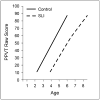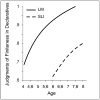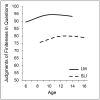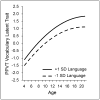Language growth and genetics of specific language impairment
- PMID: 23614332
- PMCID: PMC3684183
- DOI: 10.3109/17549507.2013.783113
Language growth and genetics of specific language impairment
Abstract
Behavioural studies of children with specific language impairment (SLI) have reported long-term growth outcomes across different dimensions of language. Genetic studies of children with SLI have identified candidate genes and putative associations of gene variants with SLI. The aims of this review are to summarize these two lines of investigation and to highlight the possible role of underlying growth timing mechanisms that influence the trajectory of language outcomes throughout childhood and into adolescence. Behavioural growth trajectories demonstrate that children with SLI have notable strengths in language acquisition, as well as limitations, across different dimensions of language. Language onset appears delayed, although the rate and pattern of change over time is similar to unaffected children. Growth rate decelerates early in adolescence for some dimensions of language. Genetic investigations reveal candidate genes that are known to influence neuronal development, and reveal possible gene interactions along a causal pathway. Epigenetic studies reveal other genetic influences implicated in the cognitive decline associated with ageing. This review highlights possible parallels between underlying genetic mechanisms and characteristics of linguistic growth trajectories. The conclusion is that new developmental perspectives are needed to inform language intervention in ways that align nurture with nature.
Figures






Similar articles
-
Toward epigenetic and gene regulation models of specific language impairment: looking for links among growth, genes, and impairments.J Neurodev Disord. 2012 Nov 24;4(1):27. doi: 10.1186/1866-1955-4-27. J Neurodev Disord. 2012. PMID: 23176600 Free PMC article.
-
Maternal input to children with specific language impairment during shared book reading: is mothers' language in tune with their children's production?Int J Lang Commun Disord. 2014 Mar-Apr;49(2):204-14. doi: 10.1111/1460-6984.12062. Epub 2013 Nov 13. Int J Lang Commun Disord. 2014. PMID: 24224893
-
Grammatical morphology is not a sensitive marker of language impairment in Icelandic in children aged 4-14 years.J Commun Disord. 2016 Jul-Aug;62:82-100. doi: 10.1016/j.jcomdis.2016.06.001. Epub 2016 Jun 8. J Commun Disord. 2016. PMID: 27314205
-
[Genetics of specific language impairments].Arch Pediatr. 2004 Oct;11(10):1213-6. doi: 10.1016/j.arcped.2004.03.121. Arch Pediatr. 2004. PMID: 15475279 Review. French.
-
Genetic and environmental risks for specific language impairment in children.Philos Trans R Soc Lond B Biol Sci. 2001 Mar 29;356(1407):369-80. doi: 10.1098/rstb.2000.0770. Philos Trans R Soc Lond B Biol Sci. 2001. PMID: 11316485 Free PMC article. Review.
Cited by
-
Understanding Dyslexia in the Context of Developmental Language Disorders.Lang Speech Hear Serv Sch. 2018 Oct 24;49(4):762-773. doi: 10.1044/2018_LSHSS-DYSLC-18-0049. Lang Speech Hear Serv Sch. 2018. PMID: 30458538 Free PMC article. Review.
-
An approach for prevention planning based on the prevalence and comorbidity of neurodevelopmental disorders in 6-year-old children receiving primary care consultations on the island of Menorca.BMC Pediatr. 2023 Jan 20;23(1):32. doi: 10.1186/s12887-023-03844-2. BMC Pediatr. 2023. PMID: 36670411 Free PMC article.
-
Learning and Overnight Retention in Declarative Memory in Specific Language Impairment.PLoS One. 2017 Jan 3;12(1):e0169474. doi: 10.1371/journal.pone.0169474. eCollection 2017. PLoS One. 2017. PMID: 28046095 Free PMC article.
-
Developmental Language Disorder: Wake and Sleep Epileptiform Discharges and Co-morbid Neurodevelopmental Disorders.Brain Sci. 2020 Nov 26;10(12):910. doi: 10.3390/brainsci10120910. Brain Sci. 2020. PMID: 33256068 Free PMC article.
-
Intellectual Disability and Language Disorder.Child Adolesc Psychiatr Clin N Am. 2017 Jul;26(3):539-554. doi: 10.1016/j.chc.2017.03.001. Child Adolesc Psychiatr Clin N Am. 2017. PMID: 28577608 Free PMC article. Review.
References
-
- Bjornsson HT, Fallin MD, Feinberg AP. An integrated epigenetics and genetic approach to common human disease. Trends in Genetics, 2004. 2004;20(8):350–358. - PubMed
-
- Brown R. A first language: The early stages. Cambridge, MA: Harvard University Press; 1973.
-
- Catts HW. Language impairments and reading disabilities. In: Kent RD, editor. THE MIT Encyclopedia of Communication Disorders. Cambridge, MA: MIT Press; 2004. pp. 329–331.
-
- Conti-Ramsden G, St Clair MC, Pickles A, Durkin K. Developmental trajectories of verbal and nonverbal skills in individuals with a history of Specific Language Impairment: From childhood to adolescence. Journal of Speech, Language, and Hearing Research. 2012;55:1716–1735. doi: 10.1044/1092-4388(2012/10-0182). - DOI - PubMed
Publication types
MeSH terms
Grants and funding
LinkOut - more resources
Full Text Sources
Other Literature Sources
Medical
